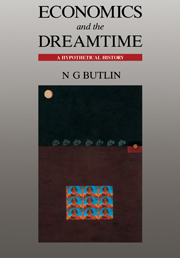Book contents
- Frontmatter
- Contents
- Preface
- Acknowledgements
- Figures
- Maps
- Tables
- Introduction
- Part I The palaeoeconomic history of Aboriginal migration
- 1 Introduction
- 2 Conventional views and alternative approaches
- 3 Non-Malthusian issues: pathways and innovations
- 4 Scarcity possibilities in Aboriginal migration
- 5 Some possible migration scenarios
- 6 A synthesis
- Part II Development, structure and function of Aboriginal economy
- Part III Disease, economics and demography
- Part IV The establishment of a bridgehead economy: 1788–1810
- Part V The takeover process: 1788–1850
- Bibliography
- Appendix 1 Preliminary model/checklist of Aboriginal migration to Australia
- Appendix 2 NOAA depth contour maps
- Index
3 - Non-Malthusian issues: pathways and innovations
Published online by Cambridge University Press: 06 July 2010
- Frontmatter
- Contents
- Preface
- Acknowledgements
- Figures
- Maps
- Tables
- Introduction
- Part I The palaeoeconomic history of Aboriginal migration
- 1 Introduction
- 2 Conventional views and alternative approaches
- 3 Non-Malthusian issues: pathways and innovations
- 4 Scarcity possibilities in Aboriginal migration
- 5 Some possible migration scenarios
- 6 A synthesis
- Part II Development, structure and function of Aboriginal economy
- Part III Disease, economics and demography
- Part IV The establishment of a bridgehead economy: 1788–1810
- Part V The takeover process: 1788–1850
- Bibliography
- Appendix 1 Preliminary model/checklist of Aboriginal migration to Australia
- Appendix 2 NOAA depth contour maps
- Index
Summary
Sea and land passages
Birdsell (in Allen et al., 1988) has made the most detailed attempt to investigate the sea and land pathways through island South-east Asia (map 1, p. 00). Assuming that the migrants and their ancestors travelled during the last ice age, it is argued that changes in sea levels during the past 100000 years significantly altered the obstacles to passage from mainland South-east Asia to Australia/New Guinea. In economists' terms, the costs of transfer were affected by the lowering of sea levels and consequent reduction of sea distances.
Ice age sea levels
Estimates of sea level changes from 135,000 BP to date have been made, with significant amendments, during the past decade. Sea level changes are, subject to some time-lag problems, good proxies for the progression of and fluctuations in ice age conditions. Graph 1 (page 15) presents estimates by Chappell and Shackleton (1988). These give for specific ‘dates’ (subject to variable margins of error) the sea level reductions in metres (also qualified by margins of error) below present levels at the Huon Peninsula in New Guinea over the past 135,000 years. Prehistorians have tended to opt for some extreme lowering of the sea or some supposed average. The graph strongly suggests that we should be concerned with fluctuations around a trend. Non-prehistorians might note that the graph should be read from right to left.
- Type
- Chapter
- Information
- Economics and the DreamtimeA Hypothetical History, pp. 14 - 34Publisher: Cambridge University PressPrint publication year: 1993



